People who own dogs understand how necessary it is to give these animals safe spaces to rest or spend time alone. This is especially true for those living in areas characterised by harsh climates; hence, there is a need for well-insulated dog shelters.
Ensuring that warmth remains within the walls of such structures calls for more than just adding another layer over existing ones; one must choose materials that best conserve the heat inside, thereby creating the desired warmth around canine abodes
In other words, insulation works by providing protection against extreme colds during the winter while mitigating excessive hotness in the summer.
Table of Contents
Understanding Insulation Needs for Dog Houses
Importance of Proper Insulation: There are many reasons why proper insulation is important in a dog house. The most obvious one is that it controls temperature; this means your pup will be warm during the winter and cool throughout the summer. Apart from making them comfortable, it also plays a big role in their health, as they can’t get hypothermia or heat stroke.
Factors Affecting Insulation Requirements: Several factors determine how much insulation should be used on a dog’s house. These may include the geographical location, size, and breed of your dog, as well as the structure of the kennel. Being aware of these aspects will enable you to make an informed choice on what type of insulation to use for safety reasons as well as comfortability concerns for your four-legged friend.
The Best Materials for Insulating a Dog House
1. Foam Board Insulation

Foam board insulation remains a widely used material for insulating dog houses. Foam boards are constructed from polystyrene, polyurethane, or polyisocyanurate, among other materials, and have excellent thermal resistance properties.
These lightweight boards can be easily cut into any desired shape. They are easy to install and don’t take up too much space. Their moisture-proof nature makes them a good option in damp conditions.
Advantages:
- High Value: It provides good thermal resistance, which makes the house warm during the winter keeping it cool in the summer.
- Lightweight: easy to carry and install.
- Moisture Resistant: No water absorption, hence no possibility of mould formation or mildew growth.
- Durability: This product is very durable, so you won’t need another replacement soon.
Disadvantages:
- Cost: Expensive nature compared to other types available.
- Installation: Requires accurate measurements for cutting and fitting.
- Safety: They should be covered entirely with something else, like wood panels because dogs might chew on them.
2. Reflective Foil Insulation
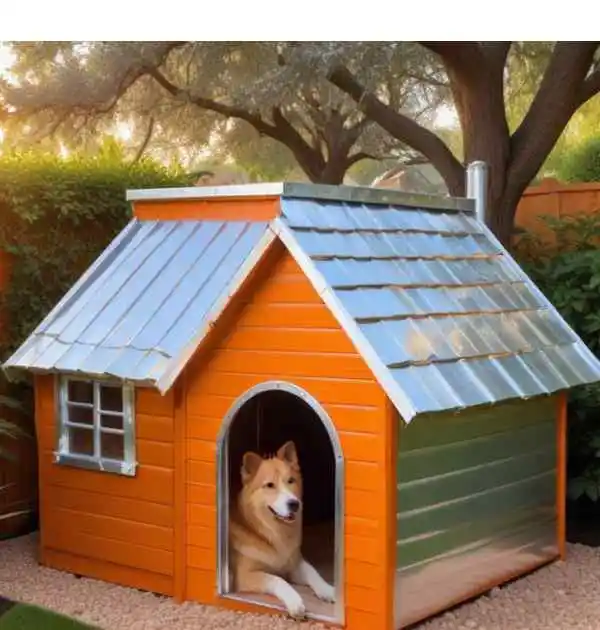
Reflective foil insulation works by reflecting heat rather than absorbing it. Which means that this kind of material is especially useful for cooling down dog houses during hot seasons. The efficiency of reflective foils can be improved if combined with additional insulating substances so as to increase thermal resistance.
Moreover, these products are lightweight and can easily be fixed to walls or roofs using staples or adhesive compounds.
Advantages:
- Effective Heat Reflection: They are good at reflecting off warmth, thus making them a perfect choice for warm climates.
- Easy Installation: Can be installed with less effort.
- Versatile: can work together with other types of insulating materials for added effectiveness in retaining warmth.
Disadvantages:
- Low Thermal Mass: It does not provide cold-weather protection on its own. Instead, it must be combined with other insulation layers.
- Durability: Easily torn apart or poked through.
- Performance: Their performance can drastically suffer if there is no space left between the foil sheets and the walls of the house.
3. Fiberglass Insulation
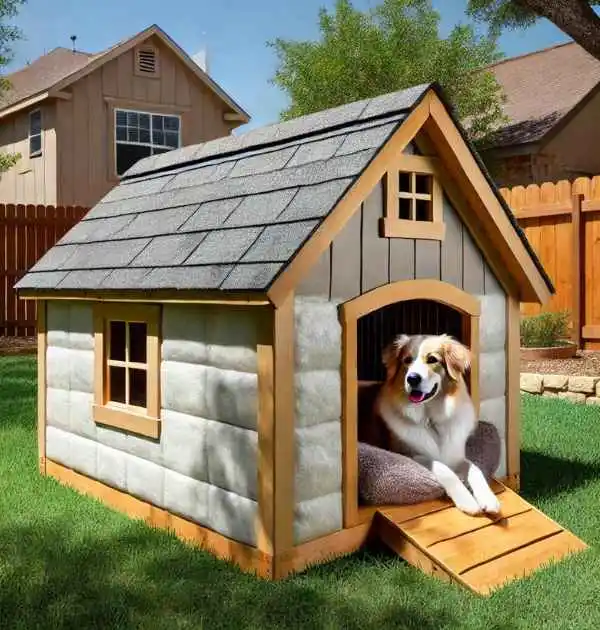
Fiberglass insulation is a common material used to insulate various structures, including dog houses. It consists of fine fibers made of glass, which provide excellent thermal insulation.
However, it should be covered with a layer like plywood or plastic sheeting so that dogs don’t touch the fibers, as they can be harmful.
Advantages:
- High Value: Provides good thermal insulation.
- Cost-Effective: More cost-effective than foam board insulation.
- Availability: Easily available in various forms.
Disadvantages:
- Health Risk: Fine glass fibers can be hazardous if they’re swallowed or breathed in, so proper cover must be maintained.
- Moisture Issues: Mold and mildew growth is another potential threat.
- Installation: Installation can be messy; protective clothing must be worn during installation to keep things clean.
4. Spray Foam Insulation
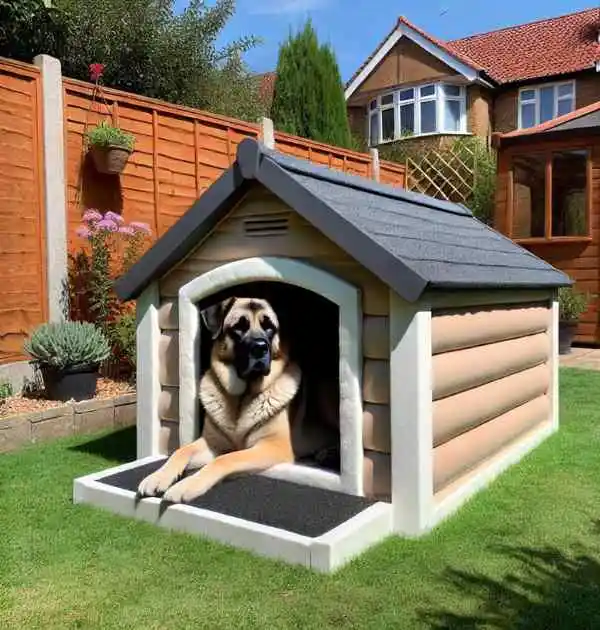
Spray foam insulation is a versatile and cost-effective choice. It expands upon application to fill any gaps and seal off air leaks. Spray foam offers excellent thermal resistance while being resistant to moisture and pests.
However, careful application must be undertaken in order to avoid over-expansion, and it should be covered to protect it from damage.
Advantages:
- Excellent Seal: Expands to fill in gaps, forming sealing that is airtight.
- High R-Value: Provides outstanding thermal resistance.
- Moisture Barrier: Low risk of mold and mildew.
Disadvantages:
- Cost: Expensive compared to other insulation types.
- Application: This requires an expert and careful application in order to prevent excessive expansion.
- Safety: It must be secured to stop dogs from chewing on it.
5. Reflective Bubble Wrap
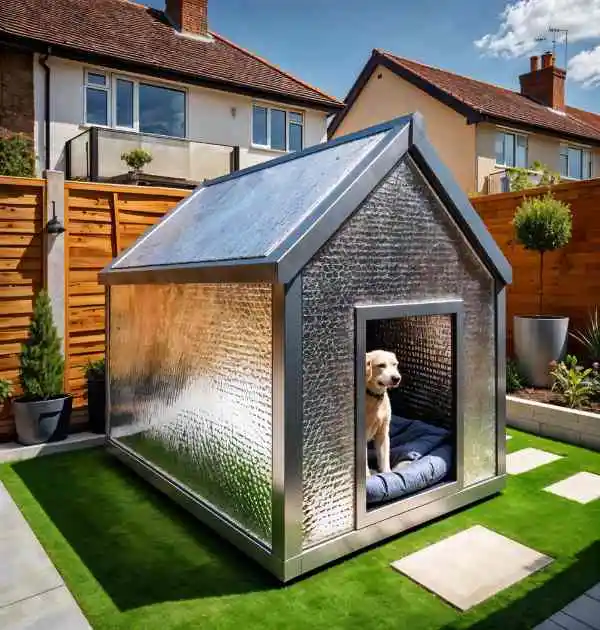
Reflective bubble wrap is bubble wrap that has been combined with reflective foil to form an insulating material. It is easy to put up and relatively inexpensive. It provides good thermal resistance. This kind of insulation works best on the inside walls as well as the roof of your dog’s kennel. It’s also light and easily cut to suit various sizes and shapes.
Advantages:
- Easy to Install: can be cut easily into different shapes according to the space available.
- Affordable: Cost-effective.
- Lightweight: Simple to hold and apply.
Disadvantages:
- Limited Insulation: Provides less thermal resistance when compared to foam boards or fiberglass.
- Durability: Not very strong.
- Performance: It is best coupled with other insulation materials.
6. Reflective bubble-wrap-insulated Panels

Insulated panels are constructed from pre-fabricated parts that integrate insulation with structural materials. They are also efficient in terms of thermal resistance and easy to install.
They are available in different sizes and thicknesses, making them suitable for different dog house designs.
Advantages:
- Pre-Fabricated: Simple to install since they are pre-fabricated.
- High R-Value: Offers superior thermal insulation.
- Durability: Sturdy and durable.
Disadvantages:
- Cost: Possibly more costly as a result of the prior fabrication process.
- Weight: More hefty than other insulation choices
7. Natural Insulation Materials
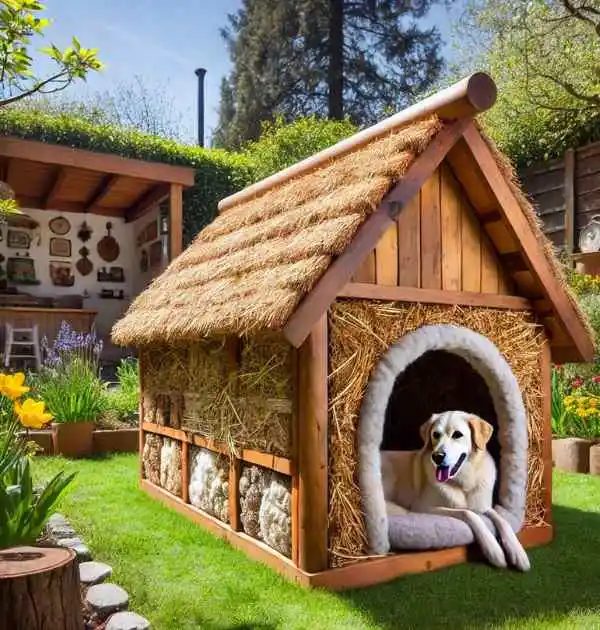
Eco-conscious homeowners looking for eco-friendly insulation materials may prefer using natural insulation materials such as straw, wool, and cork.
Such options provide reliable insulation while being eco-friendly and sustainable. However, they may require more care and protection against insects and moisture than their synthetic counterparts.
Advantages:
- Eco-Friendly: sustainable and biodegradable.
- Cost-effective: Usually less expensive, particularly if it is locally sourced.
- Safe: Non-toxicity makes it safe around pets.
Disadvantages:
- Maintenance: Needs regular replacement and maintenance.
- Pest Attraction: Encourages insect and rodent infestations.
- Moisture Absorption: Prone to soaking water, thus causing moldiness.
The best insulation for dog house
Here are three of the top insulation choices, compared to their insulation quality, installation ease, and maintenance requirements.
The best insulation for dog house
Here are three of the top insulation choices, compared to their insulation quality, installation ease, and maintenance requirements.
| Insulation Type | Insulation Value | Ease of Installation | Maintenance Requirements |
| Foam Board Insulation | High | Moderate | Low |
| Reflective Foil Insulation | Moderate | Easy | Low |
| Spray Foam Insulation | Very High | Difficult (may require professional help) | Low |
Conclusion :
Cutting and measuring an insulation material precisely is the primary aspect. Cover all cracks and gaps with caulk or weatherstripping. This will stop drafts. Ensure that the material fits well without gaps. Do not forget to insulate your floor and the roof. Use pet-safe adhesives.
Correct installation and regular maintenance are crucial to the longevity and efficiency of any item or system. If you adhere to the correct ways of installing, then you’ll avoid any future issues and ensure optimal performance. Follow the installation procedure with care and follow the proper methods for installing insulation in pet homes.

1 thought on “The Best Materials for Insulating a Dog House”